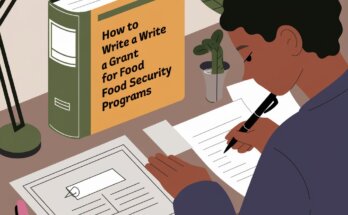When it comes to grant writing for small nonprofits, the process can feel daunting.
But with the right approach, even a small organization can secure the funding needed to make a significant impact.
Whether you’re new to the world of grants or have been struggling to win funding, this guide is designed to simplify the process for you.
By the end, you’ll be equipped with strategies and practical tips to help your nonprofit thrive. Let’s dive in!
Understanding Grant Writing: It’s Easier Than You Think!
Before we dive into strategies, let’s address a common question:
what is grant writing?
Simply put, grant writing is the process of crafting a proposal to request funding from a foundation, government, or corporation. It’s a way to explain why your nonprofit deserves funding and how you plan to use it to benefit your community.
A lot of nonprofits believe they need a professional grant writer to succeed, but that’s not necessarily true. While professional help can be valuable, small nonprofits can absolutely succeed with some basic skills and a bit of determination.
Key Strategies for Successful Grant Writing
Let’s break down some essential strategies for writing winning grant proposals that even small organizations can follow.
1. Understand Your Mission and Needs Clearly
Before you start writing, it’s crucial to understand your mission and needs. Funders want to know that your nonprofit has a clear purpose and that their investment will be used effectively. Ask yourself:
- What problem does our nonprofit solve?
- How does this grant align with our mission?
- What specific needs will this funding address?
For example, if your nonprofit provides afterschool programs for underprivileged youth, be clear about how the grant will expand your services or enhance your programs.
2. Research Potential Grant Opportunities
Research is often the most overlooked part of grant writing, but it’s critical. Not all grants are a good fit for your nonprofit, so you need to find those that align with your mission. Look for funding opportunities that prioritize your focus area, whether it’s education, healthcare, or community development. Use websites like GrantWatch, Candid, or local community foundations to discover opportunities.
Pro Tip: Keep a grant calendar to track deadlines and submission dates so you never miss an opportunity.
3. Build Relationships with Funders
Grant writing isn’t just about writing; it’s about relationship-building. Reach out to potential funders before you submit your proposal. Introduce your nonprofit, ask about their funding priorities, and see if your project aligns. A strong relationship can make your grant proposal stand out from the pile.
A Story of Success: How One Small Nonprofit Won Big
Let me share the story of Brighter Future Foundation, a small nonprofit dedicated to providing mentorship for at-risk youth. When they started applying for grants, they faced multiple rejections. But instead of giving up, they took a different approach. They focused on research, built relationships with local foundations, and refined their mission statement.
They eventually applied for a $25,000 grant to start a STEM program for girls in their community. They took the time to align their proposal with the foundation’s priorities, which focused on education and youth empowerment. After submitting their well-crafted proposal, they got a call from the foundation. They won the grant and launched their STEM program, impacting over 200 girls in the first year alone.
This story shows that even a small nonprofit can win significant funding with the right strategies and a little perseverance. If Brighter Future Foundation can do it, so can your nonprofit!
4. Write a Compelling Narrative
Funders receive hundreds of grant applications, so you need to make yours stand out. One way to do this is through storytelling. Share the stories of the people or communities you serve, and highlight the challenges they face. Show how your nonprofit makes a real difference.
For example: “Jessica, a 12-year-old girl from our afterschool program, used to struggle with her math homework. Thanks to our tutoring sessions, she now excels in her classes and dreams of becoming an engineer.”
A story like this makes your proposal more relatable and compelling.
5. Clearly Define Your Goals and Objectives
Your grant proposal should include clear goals and objectives. Funders want to know exactly what you plan to achieve with their funding. Use the SMART criteria (Specific, Measurable, Achievable, Relevant, Time-bound) to define your objectives. This makes it easier for funders to see the impact of their investment.
For instance, instead of saying, “We want to help more students,” try this:
- Goal: To improve math proficiency among 50 middle school students in our community.
- Objective: Provide weekly math tutoring sessions for 6 months, with a target of improving each student’s grade by one letter grade.
6. Create a Realistic Budget
Grant writing isn’t just about words—it’s also about numbers. A well-prepared budget shows funders that you’re serious about managing their money responsibly. Break down every expense and justify it. Show how each dollar will be used to achieve your program goals.
For example:
- $5,000 for educational materials
- $3,000 for tutor stipends
- $2,000 for program evaluation
7. Highlight Your Organization’s Strengths
Don’t forget to highlight the strengths of your organization. This might include your leadership team, past successes, or unique approach to solving community issues. Funders want to know that you have the capacity to execute the project effectively.
If you’ve received grants in the past, mention them as well—it shows that other funders have trusted your organization.
8. Proofread and Follow Submission Guidelines
Nothing can ruin a grant application faster than typos or failing to follow the submission guidelines. Funders often have specific instructions for formatting and submitting grant proposals. Make sure you follow these instructions to the letter, and always proofread your proposal before hitting send. It’s a small step that makes a big difference!
Download Your Free Guide: Top 10 Donor Stewardship Strategies
Before we wrap up, I have a special resource for you! If you’re looking to strengthen your relationships with donors, download our free guide: Top 10 Donor Stewardship Strategies for Nonprofits + Free Donor Engagement Checklist. This guide will help you maintain strong connections with your donors, ensuring they continue to support your mission. Click here to download!
9. Don’t Be Afraid to Ask for Feedback
After submitting your proposal, don’t be afraid to ask for feedback, especially if you don’t win the grant. Many funders are happy to provide insights into what you could improve. This can be a goldmine for future grant applications.
Putting It All Together: A Grant Proposal Example
Here’s a simple example to illustrate how to apply these strategies:
Nonprofit: Community Food Bank
Grant Request: $10,000 for a mobile food pantry
Goal: Reduce food insecurity for low-income families by providing monthly food distributions in underserved neighborhoods.
Objectives:
- Deliver fresh produce to 200 families monthly for 6 months.
- Conduct surveys to assess impact on food security levels before and after the program.
This example shows a clear need, specific objectives, and measurable outcomes, all of which are crucial in winning grant funding.
Conclusion: Ready to Write Winning Proposals?
Writing grants might seem challenging at first, but with practice, it becomes much easier. By understanding your mission, conducting thorough research, and crafting a compelling story, you can create proposals that capture funders’ attention.
Remember, small nonprofits have the potential to make a big impact with the right support.
If you found this guide helpful, don’t miss out on more expert tips and resources by subscribing to the Nonprofit Navigators Newsletter.
Stay up-to-date with the latest funding opportunities, grant writing strategies, and more. Subscribe now and let’s secure that funding together!
With these strategies in your toolkit, you’re well on your way to becoming a grant-writing pro. Happy writing, and good luck with your grant applications!




